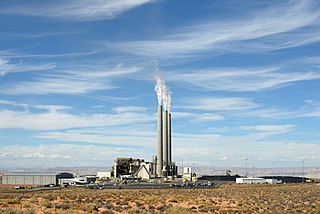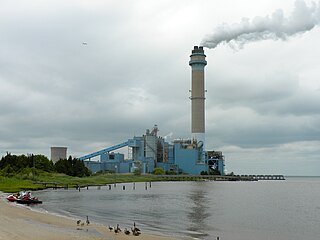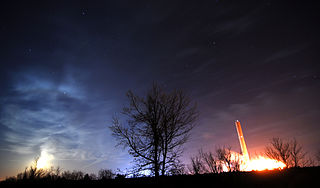
Electricity generation is the process of generating electric power from sources of primary energy. For utilities in the electric power industry, it is the stage prior to its delivery to end users or its storage.

A power station, also referred to as a power plant and sometimes generating station or generating plant, is an industrial facility for the generation of electric power. Power stations are generally connected to an electrical grid.

Electric power systems consist of generation plants of different energy sources, transmission networks, and distribution lines. Each of these components can have environmental impacts at multiple stages of their development and use including in their construction, during the generation of electricity, and in their decommissioning and disposal. These impacts can be split into operational impacts and construction impacts. All forms of electricity generation have some form of environmental impact, but coal-fired power is the dirtiest. This page is organized by energy source and includes impacts such as water usage, emissions, local pollution, and wildlife displacement.

Fiddler's Ferry power station is a decommissioned coal fired power station located in Warrington, Cheshire, England. Opened in 1971, the station had a generating capacity of 1,989 megawatts and took water from the River Mersey. After privatisation in 1990, the station was operated by various companies, and from 2004 to 2022 by SSE Thermal. The power station closed on 31 March 2020. The site was acquired by Peel NRE in July 2022.

A fossil fuel power station is a thermal power station which burns a fossil fuel, such as coal or natural gas, to produce electricity. Fossil fuel power stations have machinery to convert the heat energy of combustion into mechanical energy, which then operates an electrical generator. The prime mover may be a steam turbine, a gas turbine or, in small plants, a reciprocating gas engine. All plants use the energy extracted from the expansion of a hot gas, either steam or combustion gases. Although different energy conversion methods exist, all thermal power station conversion methods have their efficiency limited by the Carnot efficiency and therefore produce waste heat.

Navajo Generating Station was a 2.25-gigawatt, coal-fired power plant located on the Navajo Nation, near Page, Arizona, United States. This plant provided electrical power to customers in Arizona, Nevada, and California. It also provided the power for pumping Colorado River water for the Central Arizona Project, supplying about 1.5 million acre feet (1.85 km3) of water annually to central and southern Arizona. As of 2017 permission to operate as a conventional coal-fired plant was anticipated until 2017–2019, and to December 22, 2044, if extended. However, in 2017, the utility operators of the power station voted to close the facility when the lease expires in 2019. In March 2019, the Navajo Nation ended efforts to buy the plant and continue running it after the lease expires.

A thermal power station is a type of power station in which heat energy is converted to electrical energy. In a steam-generating cycle heat is used to boil water in a large pressure vessel to produce high-pressure steam, which drives a steam turbine connected to an electrical generator. The low-pressure exhaust from the turbine enters a steam condenser where it is cooled to produce hot condensate which is recycled to the heating process to generate more high pressure steam. This is known as a Rankine cycle.
The Keystone Generating Station is a 1.71-gigawatt, coal power plant located on roughly 1,500 acres (610 ha) in Plumcreek Township, southeastern Armstrong County, Pennsylvania near Crooked Creek, just west of Shelocta, Pennsylvania.

The B.L. England Generating Station, also called Beesley's Point Generating Station, was a power plant in Upper Township, Cape May County, New Jersey, United States, on the Great Egg Harbor River. The facility provided approximately 450 megawatts of generating capacity from three generating units. Two units burned coal (and up to 7 percent Tire-derived fuel) and the third unit burned bunker C oil. Its large smokestack, altered to resemble a lighthouse, contained a sulfur dioxide scrubber which removed the SO2 from the flue gas and converted it into gypsum, which can be sold. The scrubber allowed the two coal units to use less expensive high sulfur coal from West Virginia.

The Robert W. Scherer Power Plant is a coal-fired power plant in Juliette, Georgia, just north of Macon, Georgia, in the United States. The plant has four generating units, each capable of producing 930 megawatts, and is the most powerful coal-fired plant in North America. The plant is named after the former chairman and chief executive officer of Georgia Power.

Independence Power Plant is a 1,678-megawatt coal-fired base load power plant near Newark, Arkansas. The plant has two units, rated at 850 MWe each, that came online in 1983 and 1984. The plant is owned in part by Entergy Arkansas. It has a 305-meter chimney built in 1983.

Niederaussem Power Station is a lignite-fired power station in the Bergheim Niederaussem/Rhein Erft circle, owned by RWE. It consists of nine units, which were built between 1963 and 2003. It is the second-largest lignite coal power plant in operation in Germany, with total output capacity of 3,864 MW and a net capacity of 3,396 MW. The plant is estimated to have been one of the ten most carbon polluting coal-fired power plants in the world in 2018, at 27.2 million tons of carbon dioxide, and its emissions intensity is estimated to be 45.1% higher relative to the average for all fossil-fueled plants in Germany. According to the study Dirty Thirty, issued in 2007 by the WWF, Niederaussem Power Station is the second worst power station in Europe in terms of mercury emissions due to the use of lignite.

Mount Hope Bay is a tidal estuary located at the mouth of the Taunton River on the Massachusetts and Rhode Island border. It is an arm of Narragansett Bay. The bay is named after Mount Hope, a small hill located on its western shore in what is now Bristol, Rhode Island. It flows into the East Passage of Narragansett Bay and also the Sakonnet River. Mount Hope Bay has played an important role to the history of the area, from pre-colonial times to the present. While many years of sewage and industrial pollution have severely degraded the quality of the shallow waters of the bay, there are currently major efforts underway to clean up and restore it.

Dominion Energy, Inc., commonly referred to as Dominion, is an American energy company headquartered in Richmond, Virginia that supplies electricity in parts of Virginia, North Carolina, and South Carolina and supplies natural gas to parts of Utah, Idaho and Wyoming, West Virginia, Ohio, Pennsylvania, North Carolina, South Carolina, and Georgia. Dominion also has generation facilities in Indiana, Illinois, Connecticut, and Rhode Island.

JEA Northside Generating Station in Jacksonville, Florida is a major power plant, one of the three power plants owned and operated by JEA, Jacksonville's municipal utilities service. It produces electricity by burning coal and petroleum coke at Units 1 and 2, formerly the largest circulating fluidized-bed combustors, (CFBs), in the world. These combustors, completed in 2002 and rated at 297.5 megawatts each, produce enough electricity to light more than 250,000 households. In addition, Unit ST3 produces 505 megawatts of electricity by burning residual fuel oil and/or natural gas.

The Chalk Point Generating Station is an electricity-generating plant, comprising oil and natural gas fired units, owned by NRG Energy, located near the town of Eagle Harbor, Maryland, United States, on the Patuxent River.

The Mount Storm Generating Station, located on the west bank of Mount Storm Lake 2 miles (3 km) from Bismarck, West Virginia, United States, is a coal-fired power station owned by Dominion Resources. The facility's three units use around 15,000 tons of coal per day to generate more than 1,600 megawatts of electricity from the coal synfuel for around 2 million people in Northern Virginia.

The Big Sandy Power Plant is a 268 megawatt (MW), natural gas power plant owned and operated by Kentucky Power Company, a subsidiary of American Electric Power (AEP), on the shores of the Big Sandy River near Louisa, Kentucky. It was established in 1963. It was formerly a coal-fired power plant, but was converted to natural gas in 2016.
The John W. Turk Jr. Coal Plant is a base load 600-megawatt coal-fired power station in Fulton, Arkansas, operated by the American Electric Power subsidiary Southwestern Electric Power Company (SWEPCO). It provides power to customers in Arkansas, Louisiana, and Texas.

Megawatt Valley is a term applied to a geographic location which houses a large number of electricity generating stations. Historically in the United Kingdom this applied to the coal-fired power stations of the lower Trent Valley. In the mid-1980s, the valley's 13 facilities generated up to a quarter of the power demand for England and Wales. A shift to gas-fired power stations saw many of the Megawatt Valley facilities close down. The term was then associated with an area of Yorkshire centred on the River Aire that was home to Ferrybridge C, Eggborough and Drax power stations. Of these facilities only Drax remains in operation. In the United States the term has been applied to an area of West Virginia, home to five power stations.




















